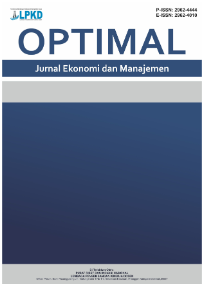Remitansi Sebagai Sumber Aliran Dana Bagi Pertumbuhan Ekonomi: Studi Pada 10 Negara-Negara Penerima Remitansi Terbesar Di Asia
DOI:
https://doi.org/10.55606/optimal.v5i2.5826Keywords:
Remitansi, Pertumbuhan Ekonomi, FDI, Konsumsi, dan InflasiAbstract
Economic growth is central to the economic life of all countries in the world, including countries in Asia that are trying to increase their economic growth by sending their workers abroad. Migrant workers or people who move to other countries to find work often send money back to their families and communities. The movement of funds from the country of employment back to the country of origin is known as remittances. Migration and remittances are crucial forces in reshaping the world economy, through the process of integration that increases the motivation of trade and financial inflows around the world with the movement of labor driving economic growth and social development. The results of the study indicate that remittances positively and significantly contribute to economic growth in the 10 highest remittance recipient countries in Asia. Likewise, the variables consumption and FDI and inflation positive significant effect on economic growth in 10 Asian countries.
References
Abduvaliev, M., & Bustillo, R. (2020). Impact of remittances on economic growth and poverty reduction amongst CIS countries. Post-Communist Economies, 32(4), 525–546. https://doi.org/10.1080/14631377.2019.1678094
Adenutsi, D. E. (2011). Financial development, international migrant remittances and endogenous growth in Ghana. Studies in Economics and Finance, 28(1), 68–89. https://doi.org/10.1108/10867371111110561
Afriska, A. E., Zulham, T., & Dawood, T. C. (2019). Pengaruh Tenaga Kerja Indonesia Di Luar Negeri Dan Remitansi Terhadap Pdb Per Kapita Di Indonesia. Jurnal Perspektif Ekonomi Darussalam, 4(2), 231–248. https://doi.org/10.24815/jped.v4i2.12947
Akay, A., Giulietti, C., Robalino, J. D., & Zimmermann, K. F. (2014). Remittances and well-being among rural-to-urban migrants in China. Review of Economics of the Household, 12(3), 517–546. https://doi.org/10.1007/s11150-013-9208-7
Al Mosharrafa, R., Sahabuddin, M., & Saha, N. (2024). Migrant Workforces, Foreign Remittance, and Economic Growth Nexus in an Emerging Country. Journal of International Migration and Integration, July. https://doi.org/10.1007/s12134-024-01170-9
Anjuani, I., Aisyah, S., Surakarta, M., Info, A., & History, A. (2024). Pengaruh Pegawai Migran Indonesia , Remitansi , Penerimaan Investasi Asing , dan Indeks Pembangunan Keuangan terhadap Pertumbuhan Ekonomi di Indonesia. 7, 11257–11266.
Annisa, R., & Jayadi, A. (2024). The Effect of Remittances on Indonesia’s Economic Growth and Exchange Rate. DLSU Business and Economics Review, 33(2), 92–100.
Artina, N. (2022). Pengaruh Tenaga Kerja Indonesia, Remitansi, Dan Inflasi Terhadap Pertumbuhan Ekonomi Di Indonesia. Jurnal Ilmiah Ekonomi Dan Bisnis Universitas Multi Data Palembang, 11(2), 338–357.
Kirana, D. N., Agung, A., & Ayuningsasi, K. (2022). E-Jurnal Ekonomi Dan Bisnis Universitas Udayana Pengaruh Remitansi, Foreign Direct Investment, Dan Inflasi Terhadap Pertumbuhan Ekonomi Indonesia. 11(01), 35–44. https://ojs.unud.ac.id/index.php/EEB/
Meyer, D., & Shera, A. (2017). The impact of remittances on economic growth: An econometric model. EconomiA, 18(2), 147–155. https://doi.org/10.1016/j.econ.2016.06.001
Tangtipongkul, K. (2019). Pengaruh Remitansi Terhadap Pertumbuhan Ekonomi. 27(2015), 232–246.
Downloads
Published
How to Cite
Issue
Section
License
Copyright (c) 2025 OPTIMAL Jurnal Ekonomi dan Manajemen

This work is licensed under a Creative Commons Attribution-ShareAlike 4.0 International License.








